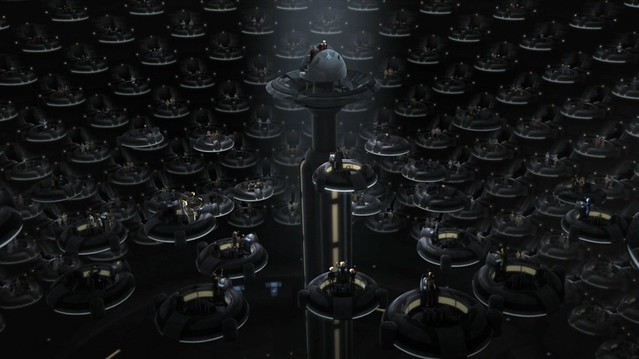Spheres of Influence: Using Rotation and Orientation as a Capture Mechanic

In thinking about Triple Triad, one of the benefits of being a digital card game is that it's easy to change a card's color as its ownership changes between players. Obviously this is more fiddly in an analog game, but not impossible.
First, let's assume a theme something like the big Galactic Senate scene in Star Wars. Each player is trying to sway dozens of planets to ally with herself. Each planet is represented by cards with four numbers on each cardinal direction, just like a Triple Triad card. But, how to reflect "ownership" of those cards in play while still keeping them on the table?
You could place a coin on each card with one player being head's and another player being tails. For more players, simply use colored stones or poker chips. Unfortunately, this obscures some of the information on the card.
You might instead print double-sided cards, with identical information on each side except for a colored border. But again, the downside is that restricts some of your ability to keep information hidden, which is a great strength of cards in the first place.
Seeking an alternative, I was inspired by the new game Keyflower, which auctions hexagonal tiles in a very clever way. When you bid for a tile, you place your bid along the edge of the tile facing you. This is particularly useful in Keyflower since the meeples you're using to bid may be many different colors, so using the actual sides of the tiles makes each player's bid quite clear.
So perhaps these tiles can show their ownership by being oriented towards one player or another. I imagine tiles or cards with a small arrow pointing at whoever owns them. Here's an example of how it would work.
You place one tile on the table to start the game. Whenever you place a tile, you probably want to it point towards you, but it doesn't have to. As you will see, there may be times it's more advantageous to orient it a different direction.
Your opponent places a tile of his own. He points it towards himself. Whenever a tile is placed adjacent to another tile, check if the newly placed tile has more dots ("influence") along its edge than the adjacent tile's edge. In this case, it does not, so no further action is taken.
You place a new tile and it does have more influence than the opponent's adjacent tile. Because this is the case, your opponent's tile must be rotated so that it points towards you. (As shown below.)
In this manner, players can "capture" each other's tiles without having to actually pick them up. This would be ideal for card-based area control games where cards are often difficult to handle. Instead of picking it up, you'd simply rotate the card in place.
The other benefit, and the one I'm most intrigued by, is that capturing also changes the landscape of influence. Capturing a tile may lead to chain reactions, as stronger faces could suddenly reveal themselves to neighboring tiles. Chain reactions can be difficult to design into an analog game, but this may indeed prove a fruitful line of inquiry. HM!

Comments
Post a Comment